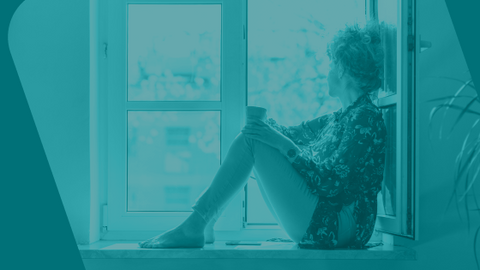
Anxiety levels have spiked worldwide, due in part to the impact of the pandemic and its associated lockdowns [1], or indeed as a complication of the infection itself [2].
Research from last year showed that in a sample of 1978 American men and women, anxiety was prevalent in 42% of the population, with women more likely to have anxiety symptoms [1].
Anxiety is a normal and necessary human emotion, the lack of which would make survival impossible [3]. However, pathological or "sustained" anxiety can lead to a whole host of other conditions and diseases.
The neuronal structures involved in the anxiety response include the amygdala, areas of the prefrontal cortex, and the anterior cingulate gyrus [3].
Anxiety presents a considerable burden to healthcare services and infrastructure globally, with the annual cost of anxiety disorders estimated at $42.3 billion ($1542 per patient) in 1990 [4].
This article explores some of the traditional methods of treating anxiety, drawbacks of their use, and presents evidence for the use of kava as a natural alternative to these strategies.
Traditional Methods to Treat Anxiety
Prescriptions for Xanax, Valium, Ativan, and other drugs in the benzodiazepine class – the class of drug most commonly prescribed to treat anxiety – have also increased in line with these worrying statistics. A study by Bachuber et al. showed that the number of adults who filled a benzodiazepine prescription increased by 67%, from 8.1 million in 1996 to 13.5 million by 2013 [5].
These data suggest that benzodiazepine prescriptions have trended upwards in general, but the pandemic brought about an increase in the prescribing of these drugs [6].
Benzodiazepines are not benign drugs. They are associated with adverse events such as tolerance, dependence, sedation, ataxia, sexual dysfunction, impaired cognition, aggression, and memory impairment [4]. They also ruin your sleep architecture despite those who use them as a sleep aid, reducing deep slow-wave sleep.
Although they may work initially, over time there is a risk of the above side effects, and stopping them "cold turkey" can be very dangerous, leading to withdrawal effects that include seizures or even death [7].
In light of the above, there is a need for safer alternatives to benzodiazepines as a means of treating anxiety.
What is Kava?
Kava, also known as kava kava or Piper methysticum, is a crop native to the islands of the South Pacific. For centuries, extracts of kava have been prepared by Pacific Islanders for medicinal and recreational purposes [8]. These include the treatment of gonorrhea but also for inducing relaxation and sleep while suppressing fatigue [4]. It has also been consumed as a remedy for anxiety, nervousness, and insomnia [8].
The major kava-exporting countries are Vanuatu, Fiji, Samoa, and Tonga, with Vanuatu accounting for the majority of the total export tonnage worldwide [8].
Kava is consumed in its traditional form as a beverage, but is also available as either an anxiolytic (anti-anxiety) agent or a dietary supplement, more recently as a recreational drink served in kava bars [8], and of course as troches too.
What are the Active Ingredients in Kava?
Kava contains 18 different so-called kavalactones, of which 15 are deemed to be active [9] and six (kavain, dihydrokavain, methysticin, dihydromethysticin, yangonin, and desmethoxyyangonin) are largely responsible for the plant’s pharmacological activity (~96%) [9]. Kavain is considered to be the principal active component in kava.
The kavalactone content is highest in the root of the plant and decreases higher up (i.e., in the leaves and stems). There is also variation in kavalactone content depending on harvest time, plant maturity, geographic location, and plant variety.
Kavalactones are lipid soluble (can be absorbed by fat in the diet) and have low absorption in the gastrointestinal (GI) tract but high absorption in the gut [10]. The gut traditionally describes the intestines whereas the GI tract refers to the entirety of the tract from the mouth to the anus.
Kava's Benefits
Kava extract induces relaxation and euphoria depending on how it is ingested, and higher doses can cause sleepiness and muscle relaxation [11]. It may also benefit nerve function, sleep quality, inflammation, and could have anti-cancer properties.
It has shown anti-inflammatory potential since the mid-1960s, during which natural kavalactones (especially kavain) showed significant inhibitory effects on edema in rat paws as well as UV light-induced inflammation of rat skin [8]. Several kavalactones also have anti-cancer activity, as shown in evidence from cancer cell culture models. DHM induced apoptosis in osteosarcoma cells through modulating the PI3K/Akt signaling pathway [8].
Kava Safety and Side Effects
Kava has effects similar to alcohol when used at higher doses, albeit without the effects of withdrawal, tolerance, or dependence. The mechanism for this involves increased GABA in the brain, therefore alcohol and kava should not be consumed together [12].
Of all trials to assess liver enzymes as a safety parameter as reported in a systematic review, no clinically significant changes were found [4]. This suggests that any risk to the liver from kava consumption is rare and not any different from non-kava users.
The only major reported side effect of kava is so-called "kava dermopathy," or the appearance of a skin lesion. However, this only appears when high amounts of kava are used over a prolonged period of time, and abates when usage is reduced or ceased [7].
Pharmacological Mechanisms of Kava
There are a number of mechanisms by which kava is proposed to act on the brain and neurotransmitters, such as by increasing GABA binding, and the reduced neuronal uptake of noradrenaline (norepinephrine) [7].
Kava may also block voltage-gated sodium channels, induce the reversible inhibition of monoamine oxidase B, and suppress the synthesis of the eicosanoid thromboxane A which antagonizes GABA receptors [7]. There is also evidence that kava extract at higher doses increases dopamine concentrations in rats [11].
Can Kava Help Anxiety?
In recent decades, kava has been introduced into Europe for the treatment of anxiety and nervous disorders such as stress and restlessness, and in the United States as a natural alternative to anti-anxiety drugs and sleeping pills [10].
A systematic review and meta-analysis (a pooled statistical study of all available evidence) from 2003 explored the effects of kava extract on anxiety [4]. The authors concluded that, although small, kava offers promise for the short-term (1 to 24 weeks) treatment of symptomatic anxiety, and adverse events were mild, transient, and infrequent.
How Can I Take Kava?
Kava is available in a range of different forms. In traditional settings, the typical dose of kavalactones ranges from 1000 mg/day (Vanuatu) to 8000 mg/drink (Fiji) [8].
It is also available as a tea, tincture/liquid, capsules, and in troche form. One method of preparation for anxiolytic kava is extraction via acetone or ethanol, allowing the solvent-free extract to be prepared as capsules and so on.
Clinical trials exploring kava as an anxiolytic have used daily doses of 20-300 mg of kavalactones for mild and moderate anxiety [8] and many experts would recommend a kava dose not exceeding 250 mg, but this really depends on the kavalactone concentration.
Kava is also available as a social drink, with bars that originated in New Caledonia expanding throughout the Pacific Islands and eventually the United States [8]. The initial purpose of these bars was as a place where young people could socialize, meet, and relax without the consumption of alcohol.
The optimal dosing strategy of kava is to start low and increase the amount slowly until the desired effects are achieved.
References
[1] J. Khubchandani, S. Sharma, F.J. Webb, M.J. Wiblishauser, S.L. Bowman, Post-lockdown depression and anxiety in the USA during the COVID-19 pandemic, J Public Health (Oxf). 43 (2021) 246–253. https://doi.org/10.1093/pubmed/fdaa250.
[2] K. Klaser, E.J. Thompson, L.H. Nguyen, C.H. Sudre, M. Antonelli, B. Murray, L.S. Canas, E. Molteni, M.S. Graham, E. Kerfoot, L. Chen, J. Deng, A. May, C. Hu, A. Guest, S. Selvachandran, D.A. Drew, M. Modat, A.T. Chan, J. Wolf, T.D. Spector, A. Hammers, E.L. Duncan, S. Ourselin, C.J. Steves, Anxiety and depression symptoms after COVID-19 infection: results from the COVID Symptom Study app, J Neurol Neurosurg Psychiatry. 92 (2021) 1254–1258. https://doi.org/10.1136/jnnp-2021-327565.
[3] A. Ströhle, J. Gensichen, K. Domschke, The Diagnosis and Treatment of Anxiety Disorders, Deutsches Ärzteblatt International. (2018). https://doi.org/10.3238/arztebl.2018.0611.
[4] M.H. Pittler, E. Ernst, Kava extract versus placebo for treating anxiety, Cochrane Database of Systematic Reviews. (2003). https://doi.org/10.1002/14651858.CD003383.
[5] A. Sarangi, T. McMahon, J. Gude, Benzodiazepine Misuse: An Epidemic Within a Pandemic, Cureus. 13 (2021) e15816. https://doi.org/10.7759/cureus.15816.
[6] C. de Dios, B.S. Fernandes, K. Whalen, S. Bandewar, R. Suchting, M.F. Weaver, S. Selvaraj, Prescription fill patterns for benzodiazepine and opioid drugs during the COVID-19 pandemic in the United States, Drug Alcohol Depend. 229 (2021) 109176. https://doi.org/10.1016/j.drugalcdep.2021.109176.
[7] Y.N. Singh, N.N. Singh, Therapeutic potential of kava in the treatment of anxiety disorders, CNS Drugs. 16 (2002) 731–743. https://doi.org/10.2165/00023210-200216110-00002.
[8] T. Bian, P. Corral, Y. Wang, J. Botello, R. Kingston, T. Daniels, R.G. Salloum, E. Johnston, Z. Huo, J. Lu, A.C. Liu, C. Xing, Kava as a Clinical Nutrient: Promises and Challenges, Nutrients. 12 (2020) E3044. https://doi.org/10.3390/nu12103044.
[9] J. Sarris, E. LaPorte, I. Schweitzer, Kava: a comprehensive review of efficacy, safety, and psychopharmacology, Aust N Z J Psychiatry. 45 (2011) 27–35. https://doi.org/10.3109/00048674.2010.522554.
[10] P.P. Fu, Q. Xia, L. Guo, H. Yu, P.-C. Chan, Toxicity of kava kava, J Environ Sci Health C Environ Carcinog Ecotoxicol Rev. 26 (2008) 89–112. https://doi.org/10.1080/10590500801907407.
[11] S.S. Baum, R. Hill, H. Rommelspacher, Effect of kava extract and individual kavapyrones on neurotransmitter levels in the nucleus accumbens of rats, Prog Neuropsychopharmacol Biol Psychiatry. 22 (1998) 1105–1120. https://doi.org/10.1016/s0278-5846(98)00062-1.
[12] H. Foo, J. Lemon, Acute effects of kava, alone or in combination with alcohol, on subjective measures of impairment and intoxication and on cognitive performance, Drug Alcohol Rev. 16 (1997) 147–155. https://doi.org/10.1080/09595239700186441.





Comments (0)
There are no comments for this article. Be the first one to leave a message!